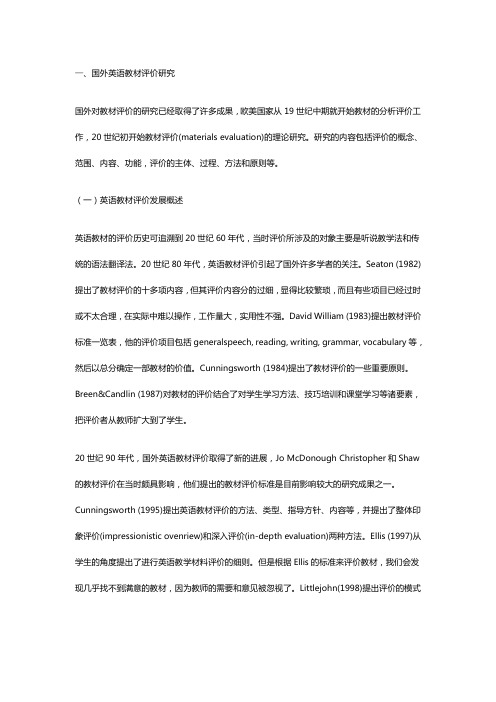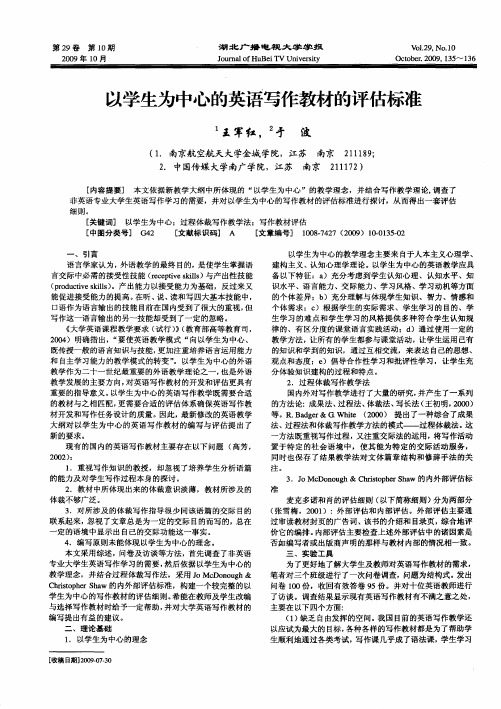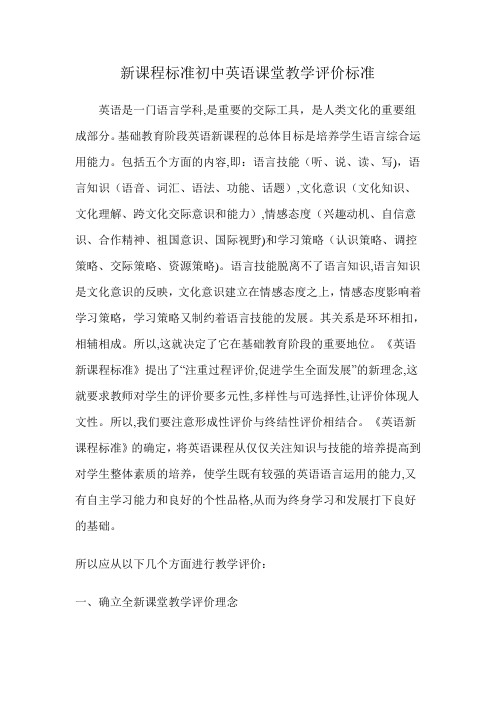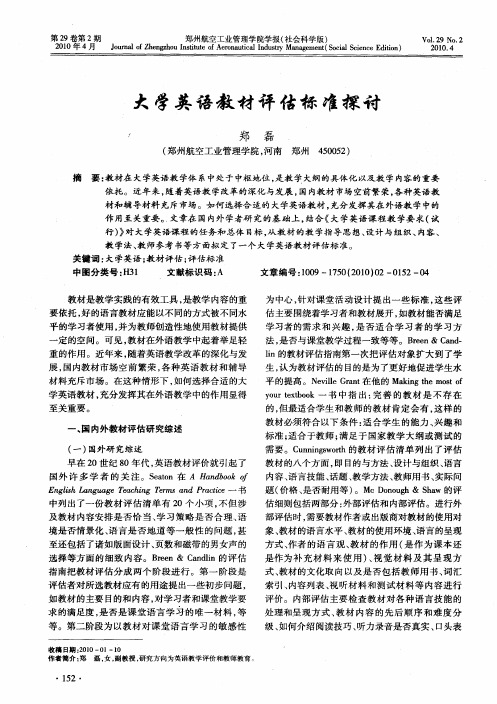英语教材评估标准
- 格式:doc
- 大小:53.50 KB
- 文档页数:3

一、国外英语教材评价研究国外对教材评价的研究已经取得了许多成果,欧美国家从19世纪中期就开始教材的分析评价工作,20世纪初开始教材评价(materials evaluation)的理论研究。
研究的内容包括评价的概念、范围、内容、功能,评价的主体、过程、方法和原则等。
(一)英语教材评价发展概述英语教材的评价历史可追溯到20世纪60年代,当时评价所涉及的对象主要是听说教学法和传统的语法翻译法。
20世纪80年代,英语教材评价引起了国外许多学者的关注。
Seaton (1982)提出了教材评价的十多项内容,但其评价内容分的过细,显得比较繁琐,而且有些项目已经过时或不太合理,在实际中难以操作,工作量大,实用性不强。
David William (1983)提出教材评价标准一览表,他的评价项目包括generalspeech, reading, writing, grammar, vocabulary等,然后以总分确定一部教材的价值。
Cunningsworth (1984)提出了教材评价的一些重要原则。
Breen&Candlin (1987)对教材的评价结合了对学生学习方法、技巧培训和课堂学习等诸要素,把评价者从教师扩大到了学生。
20世纪90年代,国外英语教材评价取得了新的进展,Jo McDonough Christopher和Shaw的教材评价在当时颇具影响,他们提出的教材评价标准是目前影响较大的研究成果之一。
Cunningsworth (1995)提出英语教材评价的方法、类型、指导方针、内容等,并提出了整体印象评价(impressionistic ovenriew)和深入评价(in-depth evaluation)两种方法。
Ellis (1997)从学生的角度提出了进行英语教学材料评价的细则。
但是根据Ellis的标准来评价教材,我们会发现几乎找不到满意的教材,因为教师的需要和意见被忽视了。
Littlejohn(1998)提出评价的模式分三步走。


小学英语教案评价及建议的评语小学英语教案评价及建议的评语随着我国对英语教育的重视程度不断提高,越来越多的小学开始注重英语教学。
而良好的英语教案则是保证英语教学质量的关键。
因此,对小学英语教案进行评价和建议非常必要。
先来谈谈小学英语教案评价的标准。
首先是语言水平方面。
教案应该简洁明了,用词准确、规范、通俗易懂;其次是教学内容方面。
教案应该符合教材内容的安排和要求,同时也要具有新颖和有实用的特点;最后是教学方法方面。
教案中要体现出多种教学方法的融合和轮换,使学生能够在不同的教学场景下全面发展。
接下来是对小学英语教案的评价。
首先是好的教学目标,一份好的教案先要确定教学目标,明确学生需要掌握的知识点,让学生知道自己需要学习的是什么。
其次是好的教学设计与教学方式。
教案从教学内容、教学方法、教学课件和作业四个方面入手,设计得越好,教学效果就越好。
第三是适合学生的教学策略,要设计多种教学策略,包括多媒体课件、情境教学等,为学生创造愉悦、互动的学习场景。
第四是教学中的评估和反馈,教师要及时检查学生的学习情况,对学生成果进行评估和反馈。
接下来是小学英语教案的建议。
首先是教材的合理使用。
教师要根据教材内容,进行合理整合,调整节奏,使得学生在业余时间和家庭环境下,能有更好的提高。
其次是个性化教育方向,因为每个学生都有自己的特点,所以教师应该综合考虑学生的个性与能力,采用多样化的教学策略,结合其他辅助教材,给学生提供更全方位的英语学习体验。
最后要注重培养学生的英语思维能力,培养学生自学和应用英语的习惯,提高学生成语、听、读、写等方面的能力。
总之,小学阶段的英语学习是关键时期,英语教学工作的重点就是教师用科学的方法创造良好的教育环境,发掘课程中的有用信息,并根据学生的情况进行相应的微调,让学生在愉快的学习氛围中学习成长。
针对小学英语教案评价和建议,要求教师关注教育内涵,注重学生的主观能动性,培养学生的探究精神,让学生在英语学习中收获更多成长。

对人教社新版高中英语教材的评价一、本文概述本文旨在对人教社新版高中英语教材进行全面、深入的评价。
新版高中英语教材是在我国教育改革的大背景下,根据新的课程标准和教育教学理念进行修订和编写的。
新教材不仅反映了我国高中英语教育的最新成果,也体现了对学生全面发展、个性化需求的高度重视。
本文将从教材内容、结构、设计理念、教学方法等多个方面进行分析和评价,以期为广大教育工作者和学生提供有益的参考。
在评价过程中,我们将重点关注新版教材的创新点,如跨学科融合、真实性材料引入、任务型教学等,同时也会对教材中的不足之处进行探讨。
本文还将结合国内外相关研究和实践经验,对新版高中英语教材进行客观、公正的评价,以期为我国高中英语教育的改革和发展提供有益的借鉴。
二、新教材基本情况介绍新教材在人教社的不断优化和更新下,展现出了鲜明的时代特征和较高的教育价值。
从外观到内容,新教材都进行了全面的革新,旨在为广大学生提供更为优质的学习资源。
从物理形态来看,新教材的纸张质量显著提升,触感舒适,不仅有利于学生的视力保护,也增强了阅读体验。
印刷清晰度达到了一个新的高度,无论是细小的文字还是复杂的图表,都能清晰可辨。
正文部分更是做到了几乎没有错字,显示出严谨的态度和专业的精神。
全书的印刷格式统一,使得整体视觉效果和谐统一,更加符合现代审美。
在内容方面,新教材也进行了大量的创新。
裁剪整齐,基本没有缺页现象,显示出了制作上的精细。
尽管有少量的折角现象,但整体上并不影响阅读。
书背平整,书脊居中,装订牢固,页码准确,每一个细节都体现出了对新版教材质量的严格把控。
尤为值得一提的是,新教材在语料的选择上,更加贴近现实生活,语言真实、地道、自然。
这不仅有助于培养学生的实际交际能力,也使他们能够更深入地理解和体验英语这门语言。
新教材还巧妙地结合了英式英语和美式英语,使学生对英语有了更全面的了解,增强了他们的跨文化交际能力。
然而,新教材也存在一些挑战和需要改进的地方。

新课程标准初中英语课堂教学评价标准英语是一门语言学科,是重要的交际工具,是人类文化的重要组成部分。
基础教育阶段英语新课程的总体目标是培养学生语言综合运用能力。
包括五个方面的内容,即:语言技能(听、说、读、写),语言知识(语音、词汇、语法、功能、话题),文化意识(文化知识、文化理解、跨文化交际意识和能力),情感态度(兴趣动机、自信意识、合作精神、祖国意识、国际视野)和学习策略(认识策略、调控策略、交际策略、资源策略)。
语言技能脱离不了语言知识,语言知识是文化意识的反映,文化意识建立在情感态度之上,情感态度影响着学习策略,学习策略又制约着语言技能的发展。
其关系是环环相扣,相辅相成。
所以,这就决定了它在基础教育阶段的重要地位。
《英语新课程标准》提出了“注重过程评价,促进学生全面发展”的新理念,这就要求教师对学生的评价要多元性,多样性与可选择性,让评价体现人文性。
所以,我们要注意形成性评价与终结性评价相结合。
《英语新课程标准》的确定,将英语课程从仅仅关注知识与技能的培养提高到对学生整体素质的培养,使学生既有较强的英语语言运用的能力,又有自主学习能力和良好的个性品格,从而为终身学习和发展打下良好的基础。
所以应从以下几个方面进行教学评价:一、确立全新课堂教学评价理念传统的评价方式是以终结性评价方式为主的评价方式,忽视人文性,以测试为评价的惟一形式,注重对单纯的书面知识考查,重结果、重成绩、重区别与淘汰,使学生的身心发展受到极大的限制。
《英语课程标准》提出英语课程的评价体系要注重体现学生在评价中的主体地位,力求评价方式的多样化。
应采用形成性评价与终结性评价相结合的方式,既关注学习过程,又关注学习结果。
为了全面、公正地对学生进行评价,不仅评价的形式要多样化,还要保证评价主体的多元化,提倡学生、同伴、教师、家长等共同参与评价。
初中英语教学评价的主要目的是为了全面了解学生的英语学习历程,激励学生的英语学习和改进教师的英语教学。

Everybody Up 5教材评估--马丽丽教材作为老师和学生开展教学活动的纲和本,对整个学习过程有着牵引性的作用。
教师对于教材设计编排的理解和运用是教材和教学之间最为关键的一个环节。
从此次“教材评估学习会”中收获很多新知识,对于如何看待教材和科学性的使用也有了清晰一点的方向。
借此机会谈下自己对正在使用的牛津版Everybody Up 5教材的浅显评估。
教材评估清单包括以下方面:理据性,可行性,针对性,可读性,连贯性,选材与排序,得体性,真实性,充分性,文化性,教育性,交互性,灵活性和指示性。
这14个方面在教材的设计上并不是孤立存在的,而是互为条件,相互支撑,紧密关联的,这样才形成和促进了教学过程的自然衔接和过度提升。
现我根据教材评估清单中的“选材和排序,文化性,教育性,交互性,可读性”这五个方面谈下自己粗浅的认识。
一.选材和排序Everybody Up 5一共分为八个单元。
从Unit1到Unit8分别是:Vacation, Camping, Class party, The Amazon Rainforest, Busy students, Making things, World travel, Computer.从单元选材排序上来看,每个主题都是刚好切合了从暑假、开学秋游,班级活动,探索自然,繁忙的学校生活,计划寒假的一个自然过渡。
每个单元的主题在选材上也预见性地和学生在现实生活中的开展活动密切相关,充分地将学习的文本知识和现实生活息息相关起来,理据性强,增加学习的真实性,也促进了在学习过程中的交互性。
二.文化性Everybody Up5的教材给我们教师留下的第一个深刻印象的是每个单元的Lesson4的设计,先从Lesson4里出现的教学题材来看,有浓厚历史意义的Marco Polo and Silk road,有鲜明自然和生物科目特色的The parts of plants和Biomes of the Earth, 有凸显勤劳坚持意识,进行价值观和思品教育的The Recital,有强烈人文意识和初涉数学数字概念的的The Pyramids以及倡导新资源观的Clean Energy的科学类主题等等,这些跨学科的设计安排,给到学习的孩子和教授的老师一个新的视野和思考方向,同时也将情感教育自然地植入其中。
两套高中英语教材的对比评估本文将对两套高中英语教材进行对比评估。
这两套教材一套是《新标准英语》,由外语教学与研究社(SFLEP);另一套是《普通高中课程标准实验教科书·英语》,由人民教育社(PEP)。
将从以下几个方面进行评估:内容与设计、语言水平、练习与活动、教育价值。
《新标准英语》教材的内容以主题划分,每个单元涵盖听说读写四个方面的语言技能。
每个单元都有新的语法知识,强调在实际语境中运用语言。
每个单元还设有文化背景知识,帮助学生更好地理解英语国家的文化。
相比之下,《普通高中课程标准实验教科书·英语》教材则更注重于词汇和语法的传统教学。
每个单元都是以新词汇和语法开始的,然后进行相关的听说读写练习。
虽然也涉及文化背景知识,但并没有像《新标准英语》那样将其融入到单元主题中。
《新标准英语》教材的语言水平较为适中,适合大部分高中生使用。
教材中的语言材料丰富多样,既有日常生活对话,又有文学作品和新闻报道等。
这有助于学生在不同情境下使用英语,提高他们的语言运用能力。
而《普通高中课程标准实验教科书·英语》教材的语言水平相对较低,更适合基础较为薄弱的学生使用。
教材中的语言材料相对较少,且缺乏多样性,因此学生的语言运用能力可能得不到充分的锻炼。
《新标准英语》教材的练习与活动设计较为生动有趣,注重培养学生的实际运用能力。
每个单元的练习都与主题相关,包括听说读写各个方面。
有些练习需要学生自己动手,比如制作海报、撰写报告等,这些活动有助于学生更好地理解和运用英语。
相反,《普通高中课程标准实验教科书·英语》教材的练习与活动设计相对传统,以选择题、填空题等书面练习为主。
虽然这些练习可以帮助学生巩固语言知识,但缺乏实际运用的机会,可能导致学生语言运用能力不足。
《新标准英语》教材的教育价值较高,除了培养学生的语言技能和知识以外,还注重培养学生的创新思维和实践能力。
教材中的问题解决部分侧重于引导学生思考并解决问题,同时提供文化背景知识,拓宽学生的视野。
Grant的教材评价表
---
一、内容准确性
评估标准:教材内容是否准确、无错误,是否与学科领域的主流观点一致。
评估结果:
+ 内容准确,无错误。
+ 与主流观点一致,反映了最新的研究成果。
+ 结论可靠,数据和信息来源可靠。
---
二、结构清晰度
评估标准:教材的结构是否清晰,章节安排是否合理,逻辑是否严谨。
评估结果:
+ 结构清晰,章节安排合理。
+ 逻辑严谨,逐步深入地展开主题。
+ 章节小结和目录有助于理解全书内容。
---
三、实用性评估
评估标准:教材是否实用,是否适合学生的学习需求,是否包含实际应用的案例或练习。
评估结果:
+ 教材内容实用,符合学生的学习需求。
+ 包含丰富的实际应用案例和练习,有助于学生理解和应用知识。
+ 提供了一些实用的工具和技巧,有助于学生提高学习效果。
---
四、案例分析质量
评估标准:教材中的案例分析是否具有代表性,是否与理论相结合,是否有助于学生理解相关概念和原理。
评估结果:
+ 案例分析具有代表性,能够很好地说明相关概念和原理。
+ 案例分析深入浅出,与理论紧密结合。
+ 提供了足够的背景信息和细节,有助于学生分析问题。
---
五、图表与插图质量
评估标准:教材中的图表和插图是否清晰、准确、易于理解,是否有助于说明相关概念和原理。
评估结果:
+ 图表和插图清晰、准确,易于理解。
+ 图表和插图能够很好地说明相关概念和原理。
+ 图表和插图的制作质量较高,视觉效果良好。
英语教材评估标准1.Cunningsworth (1995) 建议的教材评估四项标准:1.They should correspond to learners’needs. They should match the aims and objectives of the language learning program.2.They should reflect the uses (present or future) that learners will make of the language. Textbooks should be chosen that will help equip students to uselanguage effectively for their own purposes.3.They should take account of students’needs as learners and should facilitate their learning processes, without dogmatically imposing a rigid “method”.4.They should have a clear role as a support for learning. Liking teachers, they mediate between the target language and the learner.2.Grant(1987)从三个方面,学生、教师、大纲和考试,设计了选择教材教材的三个调查表:Choosing a textbook: questionaire (part I):Does the book suit your students?1.Is it attractive? Given the average age of your students, would they enjoy using it? 2.Is it culturally accepted?3.Does it reflect what you know about your students’needs and interests?4.Is it about the right level of difficulty?5.Is it about the right length?6.Are the course’s physical characteristics appropriate? (e.g. is it durable)7.Are there enough authentic materials, so that the students can see that the book is relevant to real life?8.Does it achieve an acceptable balance between knowledge about the language, and practice in using the language?9.Does it achieve an acceptable balance between the relevant language skills, and integrate them so that work in one skill area helps the others?10.Does the book contain enough communicative activities to enable the students to use the language independently.(Score: 2 points for every YES answer. 1 point for every PARTLY answer. 0 for every NO answer.)Choosing a textbook: questionaire (part II):Does the book suit the teacher?1.Is your overall impression of the contents and layout of the course favourable? 2.Is there a good, clear teacher’s guide with answers and help on methods and additional activities?3.Can one use the book in the classroom without constantly having to turn to the teacher’s guide?4.Are the recommended methods and approaches suitable for you, your students and your classroom?5.Are the approaches easily adaptable if necessary?6.Does using the course require little or no time-consuming preparation?7.Are useful ancillary materials such as tapes, workbooks, and visuals provided? 8.Is there sufficient provision made for tests and revision?9.Does the book use a ‘spiral’approach, so that items are regularly revised and used again in different contexts?10.Is the course appropriate for, and liked by, colleagues?(Score: 2 points for every YES answer. 1 point for every PARTLY answer. 0 for every NO answer.)Choosing a textbook: questionaire (part III):Does the book suit the syllabus and examination?1.Has the book been recommended or approved by the authorities?2.Does the book follow the official syllabus in a creative manner?3.Is the course well-graded, so that it gives well-structured and systematic coverage of the language?4。
If it does more than the syllabus requires, is the result an improvement?5.Are the activities, contents and methods used in the course well-planned and executed?6。
Has it been prepared specifically for the target examination?7.Do the course’s methods help the students prepare for the exam?8.Is there a good balance between what the examination requires, and what the students need?9。
Is there enough examination practice?10.Does the course contain useful hints on examination technique?(Score: 2 points for every YES answer. 1 point for every PARTLY answer. 0 for every NO answer.)Tomlinson’s (1998) 提出的评估好的教学资料标准●Materials should achieve impact●Materials should help learners to feel ease●Materials should help learners to develop confidence●What is being taught should be perceived by learners as relevant and useful●Materials should require and facilitate learner self-investment●Learners must be ready to acquire the points being taught●Materials should expose the learner to language in authentic use●The learners’attention should be drawn to linguistic features of the input●Materials should provide the learners with opportunities to use the targetlanguage to achieve communication purpose●Materials should take into account that the positive effects of instructionare usually delayed●Materials should take into account that learners differ in learning styles●Materials should take in account that learners differ in affective attitudes●Materials should permit a silent period at the beginning of instruction。